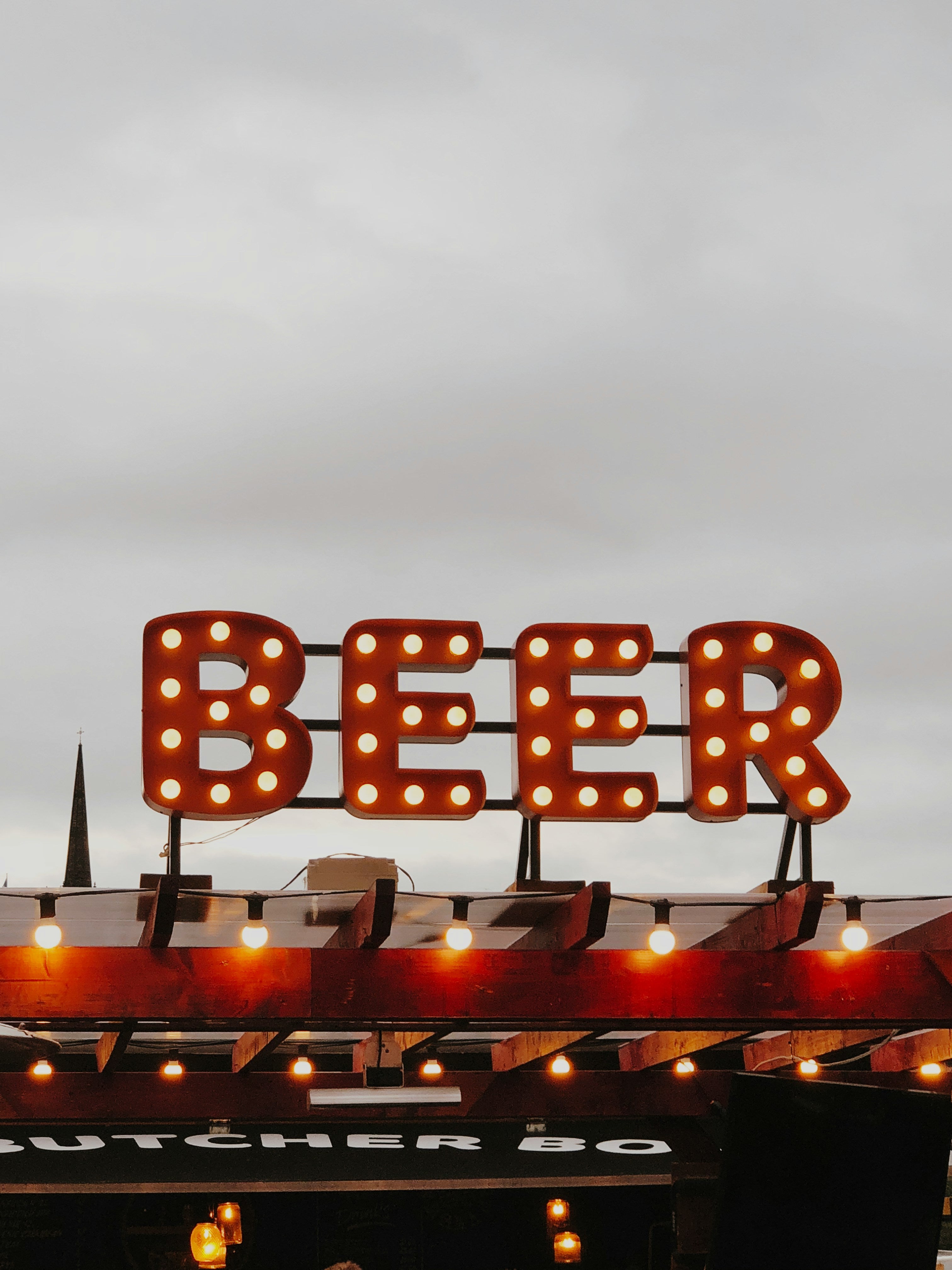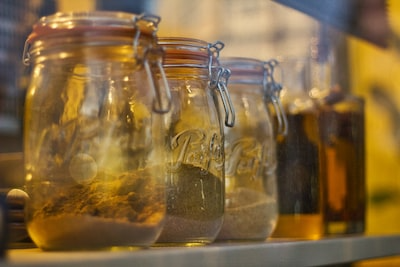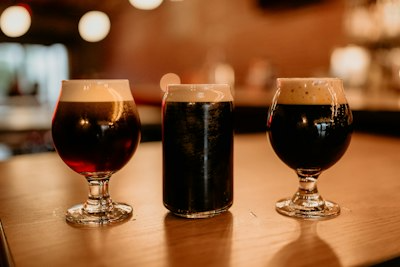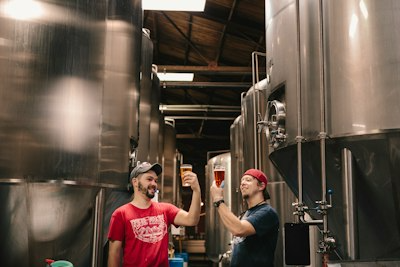
Exploring Essential Beer Ingredients With Native Botanicals
When you think of beer ingredients you may be thinking run of the mill hops, grains, yeast and water, but there's a world of complexity out there thanks to the use of native botanicals. Today we're diving into the heart of what makes your favorite pint taste so good, breaking down the primary components used in beer production, offering insights into how each element shapes the diverse landscape of beer styles.
Brewers have long harnessed grain's malty sweetness to create everything from robust stouts to crisp lagers. It doesn't stop there—hops layer on bitterness and seductive aromas while yeast works its magic turning sugars into alcohol with flavor twists along the way. And let’s not forget water; often overlooked yet vital in lending subtle character differences that can define regional brews.
Botanical beers are having a moment. This craft trend isn't just about throwing in any old botanical or flower; it's an art, one that blends history with innovation to create something entirely new yet rooted in tradition. Brewers are reaching back through time, reviving ancient practices and tastes once common before hops dominated the scene.
What can you expect from this deep dive into botanical brews?
You'll get the lowdown on how breweries are bringing back forgotten flavors and how others use ingredients like ginger or lavender for a modern twist. Plus, we’ll explore how these alternative bittering agents could be a smart move against hop market unpredictability. And if that’s not enough, we'll see why health-conscious consumers might pick up a bottle of botanic beer next time they're browsing the aisles.

Table Of Contents:
- The Essential Elements of Beer Crafting
- Crafting Flavors with Native Botanicals
-
The Impact of Water on Beer Styles
- Grains - The Backbone of Beer Flavor
- Hops - Balancing Bitterness with Aroma
- Yeast - The Alchemist in Fermentation
- Economic Benefits of Alternative Bittering Agents
- The Business Case for Botanical Beers
- Consumer Trends Driving Botanical Beer Popularity
- Sustainability and Sourcing of Botanical Ingredients
- FAQs in Relation to Beer Ingredients
- Conclusion
The Essential Elements of Beer Crafting
Every pint of beer starts with four primary ingredients that set the stage for an infinite variety of tastes and styles. These components are more than just a recipe; they're the pillars upon which all beer brewing traditions stand.
Grains - The Backbone of Beer Flavor
Malted grain, particularly malted barley, is at the heart of beer's character. During the malting process, grains undergo germination and heating, creating enzymes that later convert starches into fermentable sugars during mashing. This transformation not only provides essential sugar needed by yeast but also imparts distinct flavors ranging from sweet caramel to robust coffee notes in your final product.
All-grain beer recipes often highlight specific grain types like Maris Otter or wheat to influence flavor profiles directly related to their unique malting processes. Extract beers simplify this step by using liquid syrup or powder forms of these natural grain sugars.
Hops - Balancing Bitterness with Aroma
Hops do more than just add bitterness; they lend complexity through aroma and flavor too. Within each hop flower lies lupulin glands, housing precious alpha acids responsible for bitterness when boiled — yet it's not just about making a bitter beer.
These same hops contribute floral, citrusy, or even pine-like aromas which become prominent especially in pale ales where hoppy aromas take center stage. A closer look reveals how different varieties contain varying levels of alpha acid – something brewers carefully consider when crafting their signature brews.
Yeast - The Alchemist in Fermentation
Fermentation is where magic happens: yeast transforms sugary wort into alcohol and carbon dioxide while leaving its mark on taste too. With numerous strains available – from ale yeast thriving at warmer temperatures yielding fruity esters to lager yeast working slowly at cooler conditions for crisper finishes – each strain offers another layer to explore within your brewing adventure.
It's fascinating how this single-celled organism dictates so much. Yeast feeds on those prepared sugars turning what was once sweet wort into complex beverages loved worldwide.
Water - More Than Just a Solvent
Around 95% percent water content means that quality cannot be overlooked because it significantly affects mineral content impacting pH levels critical during mashing affecting enzyme activity as well as fermentation efficiency ultimately influencing overall taste profile beyond mere hydration needs keeping everything else suspended ready reaction ensuring nothing falls flat literally figuratively speaking. By adjusting brewing salts according to regional preferences, brewers can fine-tune their beer's flavor and mouthfeel. This careful tweaking highlights the desired characteristics of the brew, making sure every sip meets expectations.
Grains, hops, yeast, and water: these four fundamental ingredients form the bedrock of beer brewing. Each plays a unique role—grains define the backbone of flavor; hops balance bitterness with aroma; yeast is the catalyst for fermentation magic; and water's quality shapes taste.
Crafting Flavors with Native Botanicals
The Revival of Botanicals in Brewing
Beer has a storied past, stretching back over 7,000 years. Yet hops have only been part of the recipe for around 1,200. This leaves a long tradition of hop-less brews waiting to be rediscovered.
Brewers are now reaching into history's pantry to spice up their batches with botanicals like lemon myrtle and anise myrtle—bringing unique Australian flavors into the mix.
Back to the Roots with Botanical Brews
Intrigued by ancient recipes, craft brewers are turning away from traditional ingredients. They're using plants like riberry alongside well-known ones such as coriander and orange peel.
This shift is more than just about taste; it's also about crafting stories in every pint. It connects drinkers not only with new flavors but also with beer's deep roots.
The Craft of Flavor: Botanical Ingredients in Beer
Brewers are turning back the clock, drawing inspiration from ancient traditions to infuse their creations with botanicals. They're using everything from lavender and rosemary to more exotic ingredients like lemon myrtle.
Brewers are now tapping into the art of infusing native botanicals like Lemon Myrtle and Anise Myrtle to craft beers that resonate with authenticity and complexity. With beer being around 95% water, this vital ingredient provides a vast canvas for incorporating distinct flavors.

Lemon Myrtle - A Zesty Twist on Tradition
The addition of Lemon Myrtle offers a fresh take on traditional beer recipes. This native Australian botanical imparts vibrant citrusy notes to craft beers, making them stand out in an increasingly competitive market.
Lemon Myrtle's high citral content enhances beer flavor, giving brewers the ability to experiment beyond conventional hop profiles. It introduces zesty nuances that complement both light and dark brews without overpowering their intrinsic characteristics.
Anise Myrtle - Licorice-Like Complexity
In contrast, Anise Myrtle weaves a more intricate taste profile into each sip. Its sweet-spiced nuance mirrors licorice-like undertones, offering depth and warmth often sought after by discerning beer drinkers who crave something different from their pint.
This unique botanical enriches the palette further when used in darker or malt-forward styles such as stouts or porters—styles where its subtle complexities can truly shine through alongside rich malt starch elements present in these types of beers.
The Impact of Water on Beer Styles
Water is more than just a solvent in the world of brewing beer; it's an artist, painting distinct flavors across various beer styles. The regional water characteristics have played a pivotal role throughout history in shaping some of the most classic beer styles we cherish today.
Grains - The Backbone of Beer Flavor
Malted grain is where our journey begins. Grains like barley and wheat undergo the malting process, which includes soaking to start germination followed by drying with hot air to halt this sprouting. This process simulates grain growth, transforming starches into fermentable sugars and developing malt flavor that becomes the backbone for all beers—imparting essential colors, aromas, and tastes.
In particular, malted barley stands out as one of these primary ingredients due to its high enzyme content which efficiently converts its own starch reserves into sugar during mashing—a crucial step before yeast turns those sugars into alcohol and carbon dioxide. And while grains lay down this foundational tapestry of taste, they are deeply influenced by another main ingredient: water.
Hops - Balancing Bitterness with Aroma
Hops bring their own magic to brewing—their bitterness balances against the sweetness from malted grain sugars while contributing hoppy aromas thanks to oils called lupulin found within them. They come in numerous varieties each imparting different levels of alpha acid—which when boiled transforms through chemical reactions adding both hop bitterness and preservative qualities needed for certain specific beer styles like Pale Ales or England IPAs known for their floral notes.
Brewers can adjust not only what hops they use but also how they're added during brewing based on mineral content present in their water sources affecting solubility rates making each locale’s brew uniquely expressive.

Yeast - The Alchemist in Fermentation
Yeast strains are alchemists at heart, taking simple natural grain sugars created earlier by our friend malt extract or whole grains—and converting them through fermentation into something new: alcohol along with varied flavor profiles depending upon whether ale yeast (top-fermenting) or lager yeast (bottom-fermenting) is used.
This seemingly small player actually dictates much about your final product—from whether you’re sipping on a crisp Lager or enjoying fruity esters typical within many Ale Yeast fermented beverages. But, intertwined here as well is our unassuming hero: water. The pH level of the water significantly affects how effectively these yeasts perform their transformative feats, ultimately shaping the taste outcomes.
Water shapes beer's taste just as much as grains, hops, and yeast do. It plays a crucial role in creating distinct flavors we love.
Malted grain is the flavor foundation for all beers, transforming starches into sugars that become alcohol and CO2 during fermentation.
Hops add bitterness to balance malt sweetness and can vary widely based on water chemistry in different brewing locations.
Yeast is the game-changer in beer-making—depending on the strain; it turns simple sugars into complex alcohol with unique tastes influenced by water pH levels.
Economic Benefits of Alternative Bittering Agents
Botanicals are changing the game in brewing, offering a way to dodge hop shortages and price hikes. Breweries have found that ingredients like lemon myrtle and anise myrtle not only bring unique flavors but also serve as economical bittering agents.
Hops, though essential for many beers, can be unpredictable in supply. Botanical alternatives provide brewers with more control over their ingredient list and costs. It's a strategic move; when hops are scarce or expensive, having botanicals on deck keeps production steady without breaking the bank.
Brewers who embrace these alternative bittering agents aren't just surviving—they're thriving by tapping into new markets. Craft beer enthusiasts often seek out unusual brews and flavors, so breweries using distinct botanical blends stand out on the shelves creating intrigue among consumers looking for something different.
The rise of botanic ingredients isn't just about economics—it's about innovation too. By diversifying flavor profiles beyond traditional hops, craft breweries are expanding what beer can be. And while they're at it, they’re carving out niches within an increasingly competitive market—a smart business move any day.
The Business Case for Botanical Beers
Breweries are tapping into a growing niche market by infusing their beers with unique botanicals. This isn't just about brewing something different—it's about innovation and appealing to consumer curiosity.
Key Stats: The increased use of botanic ingredients adds variety and creativity to the craft beer landscape.
Brewers who diversify their portfolios can catch the eye of adventurous drinkers looking for novel flavors. With hop shortages causing headaches, turning to plants like lemon myrtle or anise myrtle makes sense—they offer complex tastes without relying solely on hops.
This strategy is more than creative; it's smart economics too. By using alternative bittering agents, breweries hedge against price volatility in the hops market—a move that could save them big time when supply gets tight.
Sustainability and Sourcing of Botanical Ingredients
Sustainable sourcing is key when it comes to botanicals in brewing. Brewers must ensure they're getting high-quality ingredients without straining natural resources or local ecosystems—a responsibility both ethical and practical.
Finding reliable suppliers takes work but pays off by ensuring consistent flavor profiles that keep customers coming back. It’s all part of crafting not just a drink, but an experience—one steeped in history yet innovative at its core.
Consumer Trends Driving Botanical Beer Popularity

Seeking Novelty and Variety
Brewers are tapping into the adventurous palates of beer enthusiasts, who crave new experiences. This thirst for innovation has led to an uptick in beers infused with unique botanicals like lemon myrtle and anise myrtle. The allure isn't just about flavor—it's a journey through history and culture, connecting drinkers to ancient traditions.
The use of hops is relatively recent in the long timeline of brewing; their widespread cultivation only dates back around 1,200 years. Before that, early beers often had sweet profiles due to a lack of bitter agents. Now breweries are revisiting these historical roots by experimenting with native Australian flora that offer complex taste dimensions beyond traditional hop bitterness.
Health-Conscious Choices
A shift towards healthier lifestyles has also permeated the craft beer scene. Consumers now lean towards beverages they perceive as having health benefits—even when indulging in alcohol—making botanical ingredients increasingly attractive.
Lemon Myrtle boasts high levels of citral while Anise Myrtle contains linalool—compounds linked with relaxation and digestive benefits—which can be compelling selling points for wellness-minded individuals exploring alcoholic options. These elements not only enhance the aroma and palate but also give consumers more reasons to choose botanically brewed beers over standard offerings.
Sustainability and Sourcing of Botanical Ingredients
Botanicals are making a big comeback in brewing, but getting them isn't always easy. Brewers keen on creating sustainable beers face real challenges when sourcing high-quality botanicals like lemon myrtle and anise myrtle.
Challenges in Sourcing Quality Botanicals
Brewers often struggle with inconsistent supply chains that can affect both availability and quality. This is why many turn to local sources, which not only supports the community but also reduces the carbon footprint associated with long-distance transportation.
To maintain consistent flavor profiles, brewers need suppliers who understand their craft. They seek partners who prioritize sustainability as much as they do, ensuring that each leaf or berry adds to the beer's character without harming the environment.
The key lies in building relationships with growers committed to eco-friendly practices. By doing so, breweries ensure a steady stream of pristine ingredients while championing green initiatives within their industry.
FAQs in Relation to Beer Ingredients
What is a botanical beer?
A botanical beer incorporates plant elements for flavor, going beyond traditional hops to jazz up the brew.
What is an earthy beer?
An earthy beer has flavors that hint at soil and nature, often from roots or herbs used in brewing.
Is there such thing as organic beer?
Sure thing. Organic beers are made with ingredients grown without synthetic fertilizers or pesticides.
What are the main ingredients of beer?
Beer's four cornerstones are grains, hops, yeast, and water. Each brings unique traits to your brew.
What is beer made out of?
Brewers craft beer using malted grains for sweetness, hops for bitterness, yeast for alcohol, and water as a base.
What does beer contain?
Your typical pint has fermented grain mash with hops added in and a heap of tiny yeast working their magic inside.
What are the raw ingredients in beer?
The raw deal? Beer comes from soaking malted barley or other cereals; then it gets spiced up with hops and energized by yeast.
Conclusion
 Beer ingredients are the unsung heroes behind every memorable pint. They blend to give us the malty backbone, bitter balance, and aromatic allure we crave. Grains set the stage with color and sweetness; hops follow up with their punch of bitterness and fragrance.
Beer ingredients are the unsung heroes behind every memorable pint. They blend to give us the malty backbone, bitter balance, and aromatic allure we crave. Grains set the stage with color and sweetness; hops follow up with their punch of bitterness and fragrance.
Yeast then steps in, transforming simple sugars into complex flavors—and let's not forget water, which subtly shifts each beer style. These elements unite in a dance of chemistry that captivates taste buds worldwide.
Native Botanicals, formerly used to enhance the flavour of spirits are now being embraced in a variety of beer styles to offer something unique, refreshing and memorable.
Every sip is a testament to tradition mixed with innovation—a story told by malted grain, hop resin, yeast strains. And as for water—its quiet role might just be the most profound.
And let’s talk buzz—breweries are even infusing caffeine-rich plants into their brews now! That's variety; that's creativity; that's botanical beers changing the game.
You came looking for what’s fresh in brewing, and you found it: from sustainable sourcing challenges to consumer thirst for novelty—and health-conscious picks—it all flows back to these botanic blends. The future looks bright, full of new twists on old classics!
You now know how vital quality beer ingredients are for crafting classics or experimenting boldly. So next time you raise a glass, remember: it's more than just a drink; it’s artistry made liquid.


